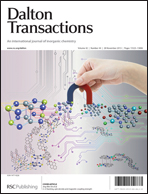Lanthanide(iii) complexes of aminoethyl-DO3A as PARACEST contrast agents based on decoordination of the weakly bound amino group†
Abstract
2-Aminoethyl DOTA analogues with unsubstituted (H3L1), monomethylated (H3L2) and dimethylated (H3L3) amino groups were prepared by improved synthetic procedures. Their solid-state structures exhibit an extensive system of intramolecular hydrogen bonds, which is probably present in solution and leads to the rather high value of the last dissociation constant. The protonation sequence of H3L1 in solution corresponds to that found in the solid state. The stability constants of the H3L1 complexes with La3+ and Gd3+ (20.02 and 22.23, respectively) are similar to those of DO3A and the reduction of the pKA value of the pendant amino group from 10.51 in the free ligand to 6.06 and 5.83 in the La3+ and Gd3+ complexes, respectively, points to coordination of the amino group. It was confirmed in the solid state structure of the [Yb(L1)] complex, where disorder between the SA′ and TSA′ isomers was found. A similar situation is expected in solution, where a fast equilibration among the isomers hampers the unambiguous determination of the isomer ratio in solution. The PARACEST effect was observed in Eu(III)–H3L1/H3L2 and Yb(III)–H3L1/H3L2 complexes, being dependent on pH in the region of 4.5–7.5 and pH-independent in more alkaline solutions. The decrease of the PARACEST effect parallels with the increasing abundance of the complex protonated species, where the pendant amino group is not coordinating. Surprisingly, a small PARACEST effect was also observed in solutions of Eu(III)/Yb(III)–H3L3 complexes, where the pendant amino group is dimethylated. The effect is detectable in a narrow pH region, where both protonated and deprotonated complex species are present in equilibrium. The data points to the new mechanism of the PARACEST effect, where the slow coordination–decoordination of the pendant amine is coupled with the fast proton exchange between the free amino group and bulk water mediates the magnetization transfer. The pH-dependence of the effect was proved to be measurable by MRI and, thus, the complexes extend the family of pH-sensitive probes.


 Please wait while we load your content...
Please wait while we load your content...